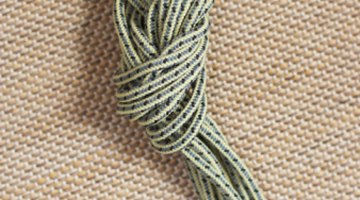How to Tie a Clothesline
Clotheslines long have been used for drying clothes, rugs and other household linens. A traditional clothesline features a small-diameter rope or cord stretched between two posts with a T on top. Several lengths of rope or cord are stretched tightly between the posts to form the clothesline.

Coated or uncoated rope or cord can be used, however, uncoated will be easier to tie. A clothesline also can be improvised at home or when camping, for example, between two stationary objects using rope and the proper knot.
Things You Will Need
- Small-diameter rope (1/4 inch)
- Knife
- Lighter
Tip
Both the bowline and taut-hitch knot common knots that can be used for a variety of tasks, especially in outdoor and recreational situations. Both knots easily can be mastered with practice.
-
Wrap the free end of a 1/4-inch diameter length of rope around a stationary object such as a post, tree or other object. Locate the rope at a level off the ground that easily can be reached for hanging clothes and will prevent them from dragging the ground once attached to the line.
-
Attach the rope to one of the stationary objects with a bowline knot and to the opposite object with a taut-line hitch. Tie the bowline to securely anchor the rope at one end and the taut-line hitch to provide a convenient and secure means of tightening the line to prevent sagging when clothes are hung.
-
Pull 3 to 4 feet of the free end of the rope around the stationary object to begin tying the bowline. Hold the free end in the right hand and the main line in the left hand.
-
Form a loop with the main rope in the left hand. Pull the line extending down from the left hand up and under the line extending up from the left hand to form the loop. Make sure the loop is on the inside of the rope toward the short end in the right hand.
-
Feed the short end of the rope up through the center of the loop and then over the side of the loop nearest to you.
-
Guide the short end of the rope under the main rope length. Pull the short end around the main length then back down through the center of the loop. Tighten the bowline knot by pulling on the main rope length.
-
Wrap the rope around the opposite stationary object. Hold the main length of rope, extending between the two objects with one hand, and the the free end of the rope in the other to begin forming a taut-line hitch knot.
-
Wrap the free end of the rope around the main line two times forming a double wrap around the main rope.
-
Pull the free end of the rope forward and wrap it around the main line in front of the first of the two double wraps.
-
Spread the loop formed by the last wrap in front of the double wraps with your fingers and push the free end of the rope through the loop. Pull the taut-line hitch knot down securely.
-
Hold the main line with one hand and the taut-line hitch knot with the other. Slide the knot toward the bowline knot at the opposite end of the line to tighten the clothesline.
The Drip Cap
- Clotheslines long have been used for drying clothes, rugs and other household linens.
- A clothesline also can be improvised at home or when camping, for example, between two stationary objects using rope and the proper knot.
- Wrap the free end of a 1/4-inch diameter length of rope around a stationary object such as a post, tree or other object.
- Hold the free end in the right hand and the main line in the left hand.
- Wrap the rope around the opposite stationary object.
- Pull the free end of the rope forward and wrap it around the main line in front of the first of the two double wraps.
References
Writer Bio
Keith Dooley has a degree in outdoor education and sports management. He has worked as an assistant athletic director, head coach and assistant coach in various sports including football, softball and golf. Dooley has worked for various websites in the past, contributing instructional articles on a wide variety of topics.
Photo Credits
- Jupiterimages/Photos.com/Getty Images
- Jupiterimages/Photos.com/Getty Images
More Articles



